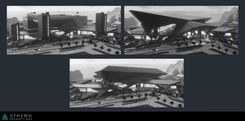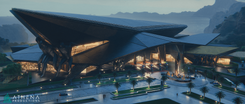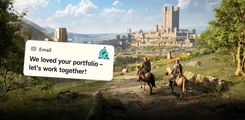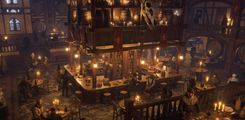Table of Contents
- The Role of Concept Art in Video Game Production
- Why Game Studios Rely on Concept Art
- Examples of Concept Art Roles
- The Concept Art Process
- The Impact of Using 2D and 3D Art in Concept Design
- The Value of Outsourcing Concept Art
- Final Thoughts
What is Concept Art? The Essential Guide
Concept art is artwork that is created to represent ideas for characters, environments, or props in films, video games, or other media. It helps guide the development process by exploring the look and feel of a project before it's fully realized.
When you play a video game or watch a film, do you ever wonder who created the visuals for that science fiction spaceship or the various planets in Star Wars? That’s where concept artists come in.
They take a written or verbal idea and come up with how that will look by using digital art techniques. Concept artists work on a wide range of creative projects, primarily in the entertainment industry, including video games, TV shows, films, animation, comic books, and advertising.
When someone asks us, 'What is concept art?' or 'What does a concept artist do?', we often find ourselves considering the best way to explain our work. The job involves much more than just creating pretty, fully rendered images—though we do enjoy sharing those on social media!
Concept art is a highly skilled and competitive field in the gaming industry, and in this article, our industry experts will share insights into exactly what concept artists do and why they are needed in the gaming industry.
The Role of Concept Art in Video Game Production
Game development is incredibly fast-paced, and creating captivating visuals and immersive experiences for players is essential.
Concept art is the first step in the visual development process, acting as a key reference for game developers to bridge the gap between abstract ideas and reality.
Whether it’s character concept art, environment design, props, or vehicle design, concept art is crucial in shaping the look and feel of a game before it moves into 3D.
Why Game Studios Rely on Concept Art
Game studios rely on concept art to ensure their projects and creative vision are on the right track from the start. Concept art serves as a visual representation of the video game’s final product before a significant amount of time or money is spent on development.
When you see your favorite character in a video game, a significant amount of iteration has taken place, with input from art directors and other members of the production team, before the character is approved to move into 3D.
If you are a photorealistic 3D character artist and begin modeling without a character design, it could take weeks before you’re able to present to your Art Director - and they may reject it if it doesn’t align with the game’s narrative and artistic vision!
Instead, by leveraging their artistic skills, a character concept artist could quickly iterate and refine ideas in a matter of days - saving time and resources compared to jumping straight into 3D modeling or animation.

A character concept artist can quickly iterate and refine ideas in a matter of days - saving time and resources.
Examples of Concept Art Roles
Concept art can cover many different types of subjects, including environment design, characters, vehicles, marketing art, and more.
Some concept artists focus on one or two subjects, while others take a more generalist approach. However, being too broad can spread you too thin. It's often better to excel in one or two areas than to handle all subjects at a mediocre level.
Here are a few roles that we have seen:
- Character Concept Artist - Focuses on the design and development of a character’s design, making sure that they align with the game’s visual style and narrative.
- Creature Concept Artist - Designs fictional and non-fictional creatures, bringing unique and imaginative creatures to life through digital painting and other techniques.
- Environment Concept Artist - Specializes in creating detailed and immersive environments that set the tone for the game's world and shape the player experience.
- Prop Concept Artist - Concentrates on designing objects, weapons, tools, and other in-game or on-screen props. Whether it’s a control panel for a ship or a magical artifact, prop artists ensure that these items are visually appealing and functional for players and the story.
- Vehicle Concept Artist - Specializes in designing vehicles, such as spaceships, cars, or fantasy transportation methods. Using their art skills, they focus on both the aesthetic and functional aspects, making sure the vehicle fits within the world’s design and narrative.
- Key Art Illustrator - Creates high-quality, promotional illustrations for marketing purposes, such as posters, box covers, or splash screens. This art is heavily focused on visual storytelling, designed to attract players and show a snippet of what the game is like.
The Concept Art Process
The concept art process can be incredibly flexible, going from one stage to the next and back again depending on feedback from the production team. We have found that most projects follow the same structure and steps, whether it is characters, environments, props, or vehicle concept art.
Brief & Reference Gathering
At the start of the process, a concept artist is given a written brief. This brief can include various references such as photos, videos, and links to other websites, typically provided by an art director or lead artist. These help to guide the concept artist by outlining key ideas, challenges, and design goals.
From there, it becomes crucial for the concept artist to gather their own references. For instance, if you were asked to draw a horse from memory, would you be able to accurately draw its bone and muscle structure? Unless you're around horses every day, probably not! This is why collecting photo references is an essential step before starting the sketching process.
Sketching and Iteration
Once the concept artist has gathered enough references, they begin sketching. At this stage, speed is the most important factor. Many designs will be discarded, so exploring as many ideas as quickly as possible is key.
Often, concept artists start in black and white to keep the sketches fast and prevent getting overly focused and bogged down with colors - that comes later!
During this phase, the concept artist will submit their sketches to their lead and receive feedback. At this point, the team may realize that some initial ideas, while promising at the beginning, don’t translate very well visually. This is the beauty of concept art - it allows room for trial and error without consuming too much time or resources.

Often, concept artists start in black and white to keep the sketches fast and prevent getting overly focused and bogged down with colors - that comes later!
Using Colors
Once a sketch - or multiple sketches - have been selected, the next step is color exploration.
By applying color theory, a concept artist can dramatically change the mood of a character or environment. For instance, an overcast, desaturated, abandoned temple can evoke a cold, foreboding feeling, while using more saturated colors - like green grass and a bright blue sky - can make the same temple feel more welcoming and peaceful.
Similar to the sketching phase, a concept artist will experiment with various color schemes and present them to their lead for feedback. Since feedback is a crucial aspect of a concept artist's work, being receptive and adaptable is essential.
Final Design
At this stage, the design and colors are finalized, and the concept artist focuses on creating a final design for the team to use and present. They may submit it to their lead for final feedback to ensure everything aligns with the game's narrative and overall design. Once completed, they move on to the next task, repeating the process once again.

The final design is often more polished, but it is important to remember that it has gone through a lot of feedback to get to this point.
The Impact of Using 2D and 3D Art in Concept Design
Over the years, the creative process has evolved from traditional art techniques to incorporating both 2D and 3D elements into the workflow.
It often involves a mix of digital painting, photo textures - commonly known as 'photobashing' - and 3D modeling. Combining these methods allows concept artists to speed up their workflow and produce more detailed and realistic artwork. Using 3D programs is particularly effective for achieving accurate lighting and perspective, often more quickly than traditional techniques.
These 3D models can then be handed off to 3D modelers and animators, saving time and helping to maintain consistency throughout the production process.


A good example is how our studio used Unreal Engine 5 to create concept art for Helldivers 2, where we could pass along our files to 3D modelers and animators. You can see in the official trailer for Helldivers 2 how one-to-one our concept art was to the final.
What Software & Tools Do Concept Artists Use?
Concept artists typically work with digital media, using graphics tablets from companies like Wacom, Huion, and XPPen. However, there is a broad range of software available, and the learning curve can be steep at first.
Our Creative Director, Ellie Cooper, notes, “There are a lot of software options out there, and it can feel overwhelming to know which one to commit to. Try different ones until you find the one you enjoy most.”
Some of the most commonly used tools by concept artists on our team include:
- Adobe Photoshop: It offers powerful features for digital painting, photo manipulation, and compositing. Photoshop has great layer organization and adjustments, which can speed up an artist’s workflow.
- Corel Painter: Preferred by many for its realistic brush strokes.
- ZBrush: A great tool for 3D modeling and sculpting.
- Blender: A free, open-source 3D modeling tool with great plugins available from the Blender community.
- Unreal Engine: Used in multiple industries, including game production, films, advertising, and more. It has powerful real-time rendering options, which means less noise and lag in your renders, making it a great choice for concept artists.

Concept artists typically work with digital media, using graphics tablets from companies like Wacom, Huion, and XPPen.
The Value of Outsourcing Concept Art
Many game studios collaborate with concept art outsourcing studios to access a wider range of subjects and artistic styles.
These studios provide game art services that include everything from character concept designs to environment concept art, offering a strategic advantage in game development.
Outsourcing can be a great resource for game studios, allowing them to leverage flexible skill sets, meet tight deadlines, and access high-quality expertise. As a result, they can focus on other aspects of game production, confident that their artistic vision is in expert hands.
Final Thoughts
Concept art is one of the first building blocks of game development, and lays the groundwork for everything that follows, acting as a reference point for team members. Whether through an in-house team or an outsourcing studio, high-quality concept art is essential. It’s the visual foundation that ensures a game is not only aesthetically pleasing but also engaging and immersive, while saving time and resources.
Athena Productions is a concept art outsourcing studio based in the UK, offering concept art services to a wide range of companies in the gaming, film, animation and advertising industry. If you would like to see how our professional concept artists can help your project, get in touch with us today!



